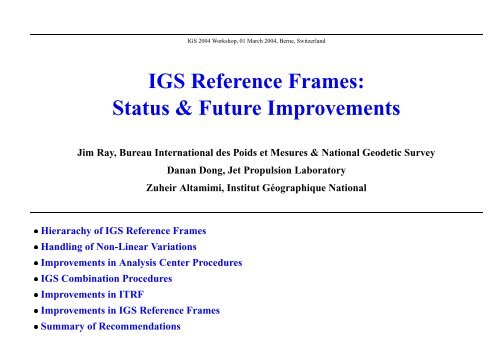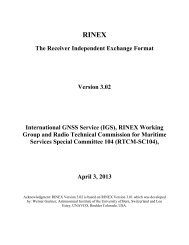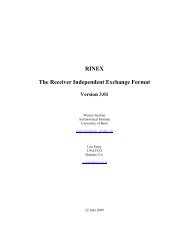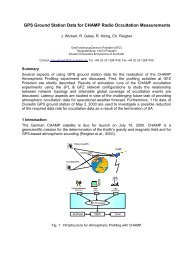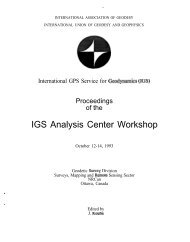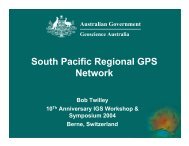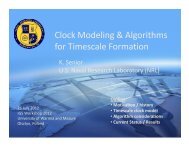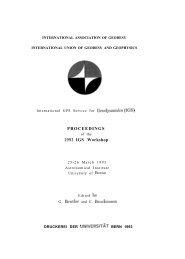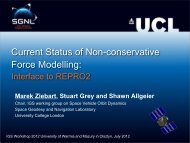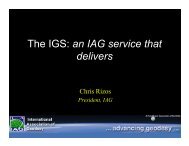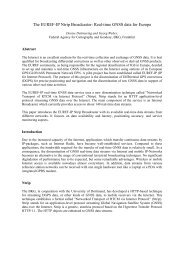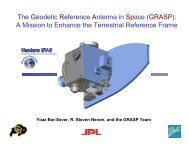IGS Reference Frames: Status & Future Improvements
IGS Reference Frames: Status & Future Improvements
IGS Reference Frames: Status & Future Improvements
You also want an ePaper? Increase the reach of your titles
YUMPU automatically turns print PDFs into web optimized ePapers that Google loves.
¡Conventional Linear Framework200-20-4040200-20-4040200-20-40<strong>IGS</strong>00 & ITRF are globally stationary with linear internal evolution:framework of points rigidly fixed to hypothetical solid Earth surfacepoints move only due to linear tectonic motions & known periodic tidesITRF origin fixed at Earth’s center of mass (CoM), including all fluidsorigin realized by average of 5 long-term SLR solutionsno-net-global frame motions w.r.t. Earth’s crust & CoMIERS Conventions 2003 specify this concept (with some inconsistencies)<strong>IGS</strong> Combined Geocenter40 (data from R. Ferland)TX (mm)TY (mm)TZ (mm)1999 2000 2001 2002 2003 2004Does not recognize “geocenter motions”centers of “instantaneous” satellite frames (weekly/monthly)appear to move w.r.t. CoMnet motion (few- ¡level) presumably due to large-scalemotions of Earth’s fluid masseshowever, technique noise is significant & agreement betweentechniques is poordespite this, real geocenter motions probably significant atsemidiurnal/diurnal/seasonal periodsgeocenter motions should be associated with large-scalesurface deformations due to loading
¤£ ¢¥§¦¨©©¤©©¤¥ Handling Geocenter MotionsFor geocenter motions, current ICRF¡ITRF transformation can be elaborated:[TRF + O] is aligned to ITRF: vector O(t) from instantaneous TRF(t) center to ITRF originmakes clear EOPs are expressed w.r.t. ITRF origin, not center of instantaneous TRFCan realize O(t) translations from Helmert transform between instantaneous TRF & ITRFmust simultaneously solve for rotation shifts & adjust EOPs consistentlyrequires uniform coverage of Earth surface for robust resultsneed fullest overlap of TRF & ITRF/<strong>IGS</strong>00 networks to minimize local/regional effectsalso, ACs must handle station-related displacements similarlyAlternatively, could substitute degree 1 loadingdeformation terms in Helmert transformwould capture both geocenter motion & largestdeformationsbut to avoid aliasing requires degree &order 6 loading termsthus dense network is also neededsource: Wu et al. (2003)Recommend <strong>IGS</strong> approach using standardHelmert transform for IERS
6Wir waren überzeugt, dass es nie wieder Krieg geben dürfe. Wir wollten beim Aufbau einer sozialenDemokratie mithelfen und waren dabei nicht allein. Es gab eine längere Wegstrecke zwischen densozialistischen, gewerkschaftlichen und christlich orientierten Jugendverbänden eine übergreifendeZusammenarbeit. Der Frankfurter Jugendring, den es immer noch gibt, hatte damals allerdings eineweiterreichende Bedeutung.Es gab so z. B. gemeinsame Veranstaltungen aller Jugendverbände. Auf dem Römerberg, umgebenvon der Trümmerlandschaft der ehemaligen Altstadt, führte die Laienspielschar der katholischeJugend, die Antikriegsstücke von Hans Hermann Mostar >>Meier Helmbrecht
¡¡£¢¤¡£¢¡¡ ¢¡¤Analysis <strong>Improvements</strong> – Subdaily VariationsAliasing problemsdiurnal geophysical variations commensurate with GPS orbital periodunmodelled effects will alias partly into GPS orbitsdiurnal/semidiurnal station errors alias into annual/semiannual signals (10 - 20%)Subdaily tidal EOPsACs should implement new IERS 2003 model – changes at few-mm level8 terms £71 termspeak differences: ¡100 ¤& ¡12 ¤; RMS: ¡30 ¤& ¡4model still needs improvement for S1 atmosphere effectHigh-frequency nutation in polar motionIAU redefinition of nutation¡all effects with periods ¥2 now polar motionold prograde semidiurnal nutations (torques on triaxial Earth) now prograde diurnal PMIERS 2003 gives 10 terms with amplitudes up to ¡15but no subroutine provided; should be included with subdaily EOPsSolid Earth tidesACs should implement new IERS 2003 model – changes up to ¡2 ¡verticalsubroutine available from Royal Observatory of Belgium (V. Dehant)
are ¢£¤¡¡¨¢¨§¢£¤¦¥¨¨§©¨¡¡Subdaily Variations (cont’d)Subdaily geocenter motionsIERS 2003 recommendations inconsistent; no model providedlargest terms ¡5 Z, 2 to 3 ¡¡¡in in X,YACs should implement using ocean tidal loading modelmodel still needed to transform orbits to sp3 terrestrial frameSubdaily atmospheric pressure loadingIERS 2003 recommendations incomplete; no model providedSpecial Bureau for Loading (van Dam et al., 2003) suggests:£¤ ¦maximum loading amplitude at the equatorestimates for¡0.8¡for S1 & ¦ ¡¡1.5¡for S2Note on non-tidal atmosphere pressure loadingincluding in GPS data analysis would be very cumbersomefar easier to handle in post-processing analysisneed to establish magnitude of errors if effect neglectedin any case, it is essential that all ACs handle effects alike
¤£¡¡¢¥¡ ¢¤¡ ¢¤Analysis <strong>Improvements</strong> – Other EffectsPole tidepast IERS Conventions were unclear about mean reference poleIERS 2003 provides two options – tabular file or linear fittabulated mean pole file ended in 2000ACs should implement linear trend for mean pole positionNutation model errorssatellite tracking highly insensitive to celestial pole offsetshowever, nutation-rate errors can alias into GPS polar motion resultsIAU1980 error at 13.66 causes PM-rate error of ¡70equivalent to fortnightly PM error of ¡150ACs should not rely on IAU1980 without applying daily nutation corrections from IERSNeglected ionospheric correctionsneglect of 2nd order effect ( ) causes few- ¡latitude errorsmainly diurnal, semiannual & decadal variations; largest near equatormore by S. Kedar, G. Hajj, M. Heflin, & B. Wilson this session
<strong>IGS</strong> Combination ProceduresStep 0. AC weekly solutions for TRF, ERPs, orbits, clocks, troposmust be internally self-consistent & unconstrainedreference frame free (or minimally constrained)sampling: 1 week/TRF; 1 d/ERPs; 15 min/orbits; 5 min/clocks; 2 hr/ZPDprovide full variance-covariance for TRF + ERPs in SINEX formatStep 1. SINEX files combined for weekly frames & daily ERPsinputs deconstrained, checked, reweighted & Helmert aligned to <strong>IGS</strong>00apparent geocenter offsets removed; scales changed to <strong>IGS</strong>00 (0 to +2 ppb)<strong>IGS</strong> combined TRF formed from inputs by weighted least-squaresweekly terrestrial frame has <strong>IGS</strong>00 origin & scaleStep 2. Orbits & clocks combinedAC rotational offsets from SINEX combination applied to orbitsno translational or scale offsets appliedAC weighting independent of SINEX combinationorbits & clocks consistent with original center-of-mass frame (not weekly TRF)
<strong>IGS</strong> Combination (cont’d)Step 3. Tropo & iono combinationsionospheric maps not sensitive to <strong>IGS</strong> frame (except via clock & satellite biases)tropo ZPDs should account for shifts in station position & scaleeffect of station position differences very minoreffect of scale difference may not be negligibleSeparate processing: Rapid & Ultra-rapid productsACs use <strong>IGS</strong>00 reference stations fixedorbits, ERPs, clocks & ZPD, but no TRF solutionproduct frames are nominally <strong>IGS</strong>00but orbit dynamics still respond to center-of-mass, so actual frame ambiguousPlanned changes – “absolute” antenna patterns for satellites & stationsby design, will enforce <strong>IGS</strong>00 scale on all <strong>IGS</strong> productscould eliminate current scale inconsistencies among productsbut GPS solution for satellite antennas must match mean scale of AC solutions
Scale Differences among <strong>IGS</strong> AC <strong>Frames</strong>Scale Difference Between the solution and the RF42codemresagfzjplMITngssioJPLmitnclScale (ppb)0-2-4source: R. Ferland1000 1050 1100 1150 1200 1250 1300GPS week
¡¢¡¢Nominal <strong>Reference</strong> <strong>Frames</strong> of <strong>IGS</strong> ProductsProduct set Origin ScaleFinals:terrestrial <strong>IGS</strong>00 VLBI/SLR viaframe (SINEX) (shifted) ITRF2000 & <strong>IGS</strong>00orbitsclockscenter-of-masscenter-of-mass¡GPS (AC average)¡GPS (AC average)troposphere ambiguous GPS (AC average)(insignificant)Rapids & Ultra-rapids:all<strong>IGS</strong>00 ¢VLBI/SLR viaITRF2000 & <strong>IGS</strong>00differs by weekly geocenter offset from <strong>IGS</strong>00all scales should shift to <strong>IGS</strong>00 when “absolute” antenna phase patterns are adoptedRapid/Ultra-rapid frames respond partially to orbital dynamics & center-of-mass origin
Summary of <strong>IGS</strong> Product InconsistenciesUsage Inconsistency RemedyPPP – fixed <strong>IGS</strong> Final origin offset from weekly apply weekly <strong>IGS</strong> geocenterorbits & clocks SINEX frame; offsets (approximate only);scale different fromweekly SINEX framenone currently availabledouble-differenced global origin offset from weekly apply weekly <strong>IGS</strong> geocenternetwork – fixed <strong>IGS</strong> Final SINEX frame offsets (approximate only)orbitslong-term global network – sp3 files aligned to transform with trnfsp3n &fixed <strong>IGS</strong> Final orbits different <strong>IGS</strong> frames adjust rot/trans offsetstropospheric path origin & scale not precisely none currently availabledelays defined (origin not significant)scales inconsistencies should vanish when “absolute” antenna phase patterns are adopted
<strong>Improvements</strong> in <strong>Future</strong> ITRF RealizationsOngoing improvements in all contributing techniqueslonger observing historiestechnique & modeling enhancementsTime series combination of TRF + EOPsallows temporal variations in station positions to be handled betteryields EOP time series consistent with ITRFcan identify outliers & other problemsNew geophysical models being developed for no-net-rotation conditionmore global coverage of Earth’s surface & use of space geodetic resultsmore sophisticated approaches using finite element modeling, etcshould give improved rotational stabilityColocation & local tie problems remainneed more colocation sites & better distributionerrors in local tie remain a major limitation
Improved <strong>IGS</strong> <strong>Reference</strong> Frame RealizationsDevelop long-range, proactive strategylong-term stability requires long viewmust take active posture to promote & achieve optimal frameshould not accept only what is currently availableDesignate “official” reference frame stationsdrop meaningless “global” station labeldevelop mutually acceptable operating standardssolicit commitments for long-term operation from stationsstrictly enforce specificationstry to improve global coverage of networkDevelop quality assessment & monitoring systemproblems at reference stations must be quickly identified & fixedImprove user interfacesdelivery of reference frame to users needs to be greatly simplifiedautomated, certified PPP service recommended
Summary of Recommendations1. Develop reinforced, long-range <strong>IGS</strong> reference frame strategy2. Verify <strong>IGS</strong> PPP product consistency3. Provide <strong>IGS</strong> PPP service to users4. Verify <strong>IGS</strong> scale consistency using absolute antenna patterns5. IERS should adopt <strong>IGS</strong> approach for geocenter motions6. Interpretation for conventional station displacement models7. Ensure consistency of <strong>IGS</strong> troposphere products8. ACs implement consistent subdaily analysis models9. ACs implement linear mean pole for pole tide10. ACs do not rely on uncorrected IAU1980 nutation model11. Consider adding 2nd order ionosphere correction


